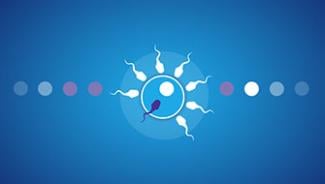Fertility options for LGBTQ+ couples: Get the basics

Talking to your doctor is especially important when considering your fertility options. This article should not be considered medical or legal advice.
Fertility options for LGBTQ+ couples are wide-ranging — more so than you might think! Here we look at four common options — intracervical insemination, intrauterine insemination, in vitro fertilization and reciprocal IVF — as well as considerations for sperm banks, egg banks, sperm donations and egg donations.
Intracervical insemination (ICI)
Intracervical insemination (ICI), also called at-home insemination, can be done on your own or with the aid of a midwife or nurse practitioner.1 Fresh or cryopreserved (frozen) donor sperm is inserted into the vagina using a needleless syringe or cervical cap.1
Anecdotal (not scientific) evidence online suggests that a menstrual cup can be used as well, but keep in mind that menstrual cups are only FDA approved to hold period blood, not semen.2 Because STIs can be transmitted through semen, it’s important that any donor sperm be obtained through a fertility clinic where it can be pre-screened.1
When considering ICI, there are a couple of important points to know up front:
- It’s best for those under 35 who have regular periods and no known fertility issues.1
- Plan on scheduling an exam with a gynecologist or reproductive endocrinologist to discuss any potential fertility problems, such as ovulatory problems caused by polycystic ovarian syndrome (PCOS) or primary ovarian insufficiency (POI), blocked fallopian tubes due to endometriosis or pelvic inflammatory disease, uterine anatomical abnormalities or uterine fibroids.1,3
- ICI may not be as successful as IUI. A 2022 study in “Human Reproduction” found that, when using cryopreserved donor sperm in the natural cycle, ICI resulted in 24% live births compared to intrauterine insemination (IUI), which resulted in 39%.4
- Because laws vary state by state,1 it’s good to know your legal rights regarding parentage.
Talk to your doctor for more information about this option and whether it may be right for you.
Intrauterine insemination (IUI)
Unlike ICI, IUI can’t be performed at home. Generally, it follows the process outlined below, but your doctor can provide more detailed information.
Before the insemination takes place, fertility medication is often prescribed to stimulate ovulation.5,6 Next, blood tests and ultrasounds are performed to monitor when the egg(s) are mature.5,6 Sometimes an hCG (human Chorionic Gonadotropin) trigger shot is administered.6 The insemination usually is scheduled within 24 to 36 hours after the hCG trigger shot or LH (luteinizing hormone) surge, which can be determined via blood, urine and ultrasound testing to predict ovulation.6
IUI can be done with fresh or cryopreserved (frozen) donor sperm.5,6 The sperm is separated (using a technique called a sperm wash) to collect the best-quality sperm.5,6 The sperm is then inserted through the cervix into the uterus via a thin, flexible catheter.1,5 If you’re considering IUI, keep these things in mind:
- IUI is generally less expensive and invasive than in vitro fertilization (IVF).5
- To start the process, you will need to visit a fertility specialist who will perform diagnostic tests to determine any potential fertility problems.5,6
In vitro fertilization (IVF)
According to the Office on Women’s Health, in vitro fertilization is considered the most effective type of assisted reproductive technology (ART).3 IVF must be done under the guidance of a fertility specialist or reproductive endocrinologist.7 In essence, IVF is the combining of sperm with eggs in a laboratory, which may result in embryos that can be transferred to a uterus or cryopreserved to use later.1 IVF is a step-by-step process. Below is a quick snapshot — you can learn more about how IVF works from your doctor, or read our blog post to get more details.
- Stimulation: Fertility drugs are given to boost egg production and monitoring is done via ultrasounds and blood tests.8-10
- Egg retrieval: A minor surgery, called follicular aspiration, collects eggs by inserting a thin needle through the cervix into the ovary.9,10
- Embryo fertilization (insemination): Sperm is placed with or injected directly (called intracytoplasmic sperm injection or ICSI) into the best-quality eggs in a laboratory dish, stored in an environmentally controlled setting and monitored.9,10 Once the fertilized eggs divide, they are called blastocysts and then become embryos.9,10
- Embryo transfer: One or more embryos are placed into the womb via the vagina through the cervix.9,10 Healthy embryos not transferred can be frozen and stored.9,10
Reciprocal in vitro fertilization (IVF)
According to Resolve: The National Infertility Association, reciprocal IVF allows two people who have working female reproductive organs, such as lesbian couples and trans men, to both contribute to the IVF process.11
Reciprocal IVF is also called partner IVF, co-maternity IVF, partner-assisted reproduction and reception of oocytes from partner (ROPA).11 Like IVF, reciprocal IVF is a step-by-step process, but with a few differences.
- Partner A, the egg donor (sometimes referred to as the genetic mother), participates in the stimulation and egg retrieval steps.11
- Then embryo fertilization occurs using donor sperm in a laboratory setting.11
- Once an embryo exists, partner B or a gestational carrier receives the embryo transfer.11
Talk to your doctor for additional information on this process.
What about sperm donation, sperm banks and egg donation?
Sperm can be donated from a known or unknown donor.1 According to Family Equality’s Path2Parenthood, known donors can be less expensive as they are often a friend or relative who, if desired, can also serve as another personal connection with the child.1 With a known donor it’s possible to use a fresh sample, but fresh samples aren’t regulated and tested like frozen samples.1 Laws vary state by state, so it’ important to know your legal rights.1
According to Family Equality’s Path2Parenthood, anonymous donors work with a sperm bank.1 Depending on the agreement, the sperm donor’s identity may be unknown or may be released when the child is 18 years old (although you can’t be certain what information could someday be accessed online or via DNA testing in the future).1 Currently, unknown donors have no legal parentage rights.1
Family Equality provides a list to think about when choosing between a known and unknown sperm donor.
Sperm banks
Sperm banks are regulated by the U.S. Food & Drug Administration (FDA).12 According to Family Equality’s Path2Parenthood, donors must provide a detailed personal and sexual history, and are screened for STIs and genetic diseases.1 Working with a sperm bank that controls the number of live births that result from the sperm it stores from a specific donor may reduce the chance of half siblings.1
Egg banks
Egg banks are also regulated by the FDA.12 Family Equality’s Path2Parenthood states that egg donation agencies collect full medical histories and conduct genetic and psychological screenings.1
Egg donation
Egg donation allows a gestational carrier to carry a baby to term without using their own egg.1 Also, if you and/or your partner do not have a uterus, one of you has banked sperm and you wish to have children genetically linked to the person who banked the sperm, you can use IVF along with an egg donor and a gestational surrogate. Reading through these different options may seem daunting at first. Know that support exists — and that one of the best ways to find it is through your doctor, an LGBTQ+ health clinic and LGBTQ+ family planning resources. Our guide to LGBTQ+ pregnancy is another source for general information on this topic.
Related Articles
- Family Equality Council, Path2Parenthood. Parenting options for the LGTBQ+ community: a how-to guide. Updated 2018. Accessed April 4, 2023. https://www.stanfordchildrens.org/content-public/pdf/handbook-parenting-options-lgbtq-community.pdf
- National Women’s Health Network. Can using a menstrual cup help you get pregnant? Updated April 30, 2019. Accessed April 4, 2023. https://nwhn.org/ive-been-hearing-about-the-use-of-menstrual-cups-as-a-method-to-get-pregnant-what-are-they-is-it-safe
- U.S. Department of Health & Human Services, Office on Women’s Health. Infertility. Updated February 22, 2021. Accessed April 4, 2023. https://www.womenshealth.gov/a-z-topics/infertility
- Kop PAL, van Wely M, Nap A, et al. Intracervical insemination versus intrauterine insemination with cryopreserved donor sperm in the natural cycle: a randomized controlled trial. Hum. Reprod. 2002;37(6),1175-1182, doi: 10.1093/humrep/deac071. https://academic.oup.com/humrep/article/37/6/1175/6572704
- Johns Hopkins Medicine. Intrauterine insemination (IUI) treatment. Accessed April 4, 2023. https://www.hopkinsmedicine.org/gynecology_obstetrics/specialty_areas/fertility-center/infertility-services/intrauterine-insemination.html
- The National Infertility Association, Resolve. Intrauterine insemination (IUI). Accessed April 4, 2023. https://resolve.org/learn/what-are-my-options/intrauterine-insemination/
- The National Infertility Association, Resolve. The IVF process. Accessed April 4, 2023. https://resolve.org/learn/what-are-my-options/in-vitro-fertilization/the-ivf-process/
- The American College of Obstetricians and Gynecologists. Treating infertility. Updated August 2022. Accessed April 4, 2023. https://www.acog.org/womens-health/faqs/treating-infertility
- A.D.A.M. Medical Encyclopedia. In vitro fertilization (IVF). Updated January 10, 2022. Accessed April 4, 2023. https://medlineplus.gov/ency/article/007279.htm
- Choe J, Shanks, AL. StatPearls [Internet]. In vitro fertilization. Updated September 5, 2022. Accessed April 4, 2023. https://www.ncbi.nlm.nih.gov/books/NBK562266/
- The National Infertility Association, Resolve. Reciprocal IVF. Accessed April 4, 2023. https://resolve.org/learn/what-are-my-options/lgbtq-family-building-options/reciprocal-ivf/
- Food & Drug Administration. What you should know – reproductive tissue donation. Updated April 25, 2019. Accessed April 5, 2023. https://www.fda.gov/vaccines-blood-biologics/safety-availability-biologics/what-you-should-know-reproductive-tissue-donation

Get pregnant naturally
Ovulation tests are accurate and simple to use.

How to get pregnant faster
There are a few key things you need to know if you want to maximise your chances of getting pregnant.




